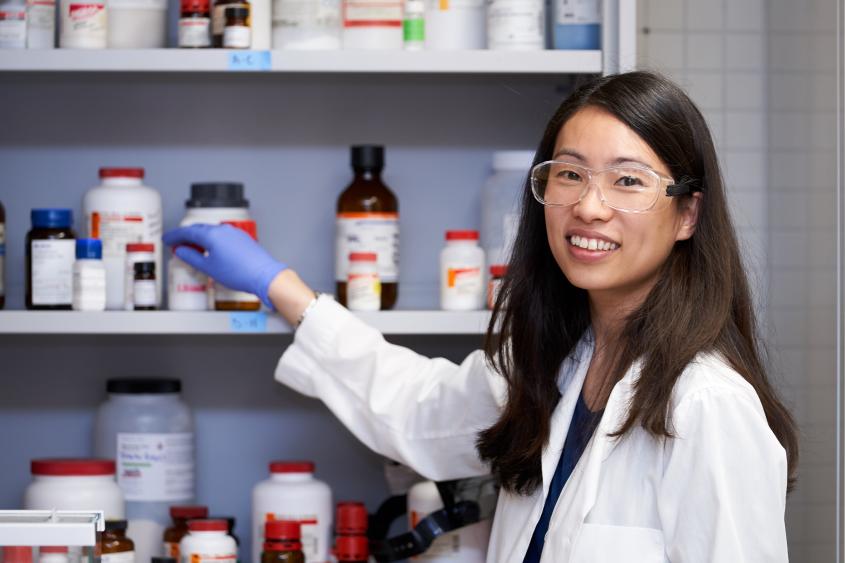Pamela V. Chang featured on Cornell Research
Our Bodies, Our Health, Our Gut Bacteria
Why are gut microbes so important to our health? What is their function in our bodies?
Each of us has trillions of microbes living in our gut. As we go about our day, many of these microbes regulate processes in our bodies through the production of metabolites, small molecule compounds that are produced by enzymes within their cells. Gut microbes are foreign organisms living inside of us, but they are crucial to our health. Our bodies have to maintain a kind of detente with them, ensuring that we coexist peacefully together in symbiosis.
“We’re constantly being challenged by these microbes,” says Pamela V. Chang, Microbiology and Immunology. “When we eat, there is bacteria in our food, and then it gets into the gut. The question is how does the gut react to that?” Understanding the microbiota in the gut is especially important because certain microbes are necessary to maintain protection against infection, according to Chang. A certain balance of microbes is needed for conditions in the gut to be optimal. When an imbalance occurs, the immune system can go haywire, causing chronic inflammation, which in the gut can lead to inflammatory bowel disease (IBD) like colitis or Crohn’s Disease.
Microbes and Control of the Gut’s Inflammatory Condition
One aspect of the Chang Lab’s research focuses on the creation of chemical tools that will target specific pathways important to controlling the immune system. The genesis of the work goes back to Chang’s days as a postdoctorate at Yale University School of Medicine. There she discovered that a metabolite called n-butyrate made by gut bacteria can control the inflammatory state of the gut. This may be a key to why healthy bodies don’t identify the good microbes as foreign pathogens to be attacked and destroyed. “The big question is how do we maintain tolerance to all those microbes that live in our body,” Chang says. “This metabolite that I discovered seems to do just that. It turns off inflammation by turning off certain immune cells.”
N-butyrate inhibits histone deacetylases (HDACs), an enzyme that controls the activity of macrophages—an immune cell activated by pathogens to fight infection. Inflammation occurs when macrophages secrete proteins that recruit additional immune cells to join the fight against the infectious agent. Using her discovery of the HDAC-inhibiting metabolite as a starting point, Chang and PhD student Bibudha Parasar, Chemistry and Chemical Biology, created a chemical tool that can turn off HDACs and thus stop inflammation by decreasing the activity of macrophages. Just as importantly, the new tool has the ability to target specific sites where inflammation is present while ignoring unaffected tissue.
“When people have an inflammatory disease like IBD, they take systemic drugs that have a lot of side effects,” Chang explains. “In many cases people develop infections because the anti-inflammatory drug turns off their immune system, and they become more susceptible to whatever is out there. There are very few local therapies that are available to treat something like IBD.” By selectively delivering the HDAC inhibitor directly to the site in the body where it is needed, unwanted side effects can be avoided and the rest of the host immune system should remain intact.
“When we eat, there is bacteria in our food, and then it gets into the gut. The question is how does the gut react to that?”
Chang and her team use a pharmacological version of the HDAC inhibitor rather than the metabolite itself because the pharmacological version is much more potent. This allows them to use a much lower dose to achieve the same effect. “We deliver the inhibitor using light irradiation,” Chang explains. “When we shine a light on the target site, we activate the inhibitor compound which has a masking group on it that falls off through the process of photo chemistry, releasing the inhibitor only where the light shines.”
So far the researchers have shown their new technology works on macrophages grown in a lab. The next step will be to test the tool in mouse models. If all works out, future applications may include using the Chang Lab’s technology to treat topical inflammatory diseases like atopic dermatitis or psoriasis. For inflammation inside the body, an endoscope might be fitted with LEDs, then inserted inside the body cavity to shine a light on the target area. “If you can turn off inflammation in one location and nowhere else, you can treat the problem and your immune system will still protect your health,” Chang says. “That would be really amazing if it’s successful.”
Figuring Out the Crosstalk Between Bacteria and the Human Host
Another aspect of Chang’s research focuses on understanding which gut microbes secrete which metabolites and what effects the metabolites have on the host body. “My goal is to figure out all the metabolites’ functions,” Chang says. “What do the different metabolites do to the host and how do they do it? Are they recognized by different receptors or do they activate or inactivate certain pathways? We want to understand this language that’s going on inside our bodies, this crosstalk between the bacteria and the human host.”
The more Chang and her lab know about how the microbiota affect the host, the easier it will be for them to start developing chemical tools based on those discoveries. “I hope that the discoveries we make will feed into the tools and the tools will help us discover more about the biological pathways,” Chang says. “The research will come full circle.”
by Jackie Swift
This article originally appeared on the Cornell Research website.






